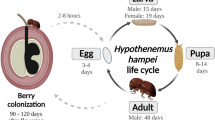Abstract
The histology of resistance to coffee berry disease (CBD) was studied in artificially inoculated berries and hypocotyls of 6-week old seedlings of a number of varieties ofCoffea arabica L. In resistant varieties a phellogen was quickly formed some cell layers below the site of infection and progress of the fungal invasion was effectively blocked by a complete barrier of suberized cells. Such barriers were absent or incompletely developed in CBD susceptible varieties. A highly significant correlation (r=0.87) was found between the frequencies of complete barrier formation in berries and in hypocotyls of young seedlings, while both were also highly correlated to observed mature plant resistance (r>-0.93). Resistance to CBD in arabica coffee may to an important extent be based on the formation of cork barriers. These cork barriers confine the pathogen to the small volume of tissue external to the barrier so that its growth is severely restricted. Such a resistance mechanism is likely to be stable (race-nonspecific). The almost identical response to infection observed in berries and hypocotyls provides further evidence that plants with resistance to CBD can be reliably preselected by the hypocotyl inoculation test.
Samenvatting
Het mechanisme van de resistentie tegen de koffiebessenziekte werd nader onderzocht bij een aantal rassen vanCoffea arabica aan de hand van anatomische studies van groene bessen en van hypocotyle stengelleden van 6-weken oude kiemplanten, die vooraf waren geïnoculeerd. Bij resistente rassen bleek steeds enkele cellagen beneden het punt van infectie een wondkurk te ontstaan, dat verdere groei van de schimmel in het waardplantweefsel onmogelijk maakte. Dit kurk werd niet of zeer onvolledig gevormd bij vatbare planten. Er bleek een zeer hoge correlatie (r=0.87) te bestaan tussen de mate van voorkomen van wondkurk na infectie bij bessen en bij hypocotyle stengelleden. De mate van vorming van wondkurk was bovendien zeer goed gecorreleerd met de mate van de in het veld waargenomen resistentie tegen de koffiebessenziekte (r≥0.93). Dit doet vermoeden dat resistentie tegen de koffiebessenziekte in hoge mate wordt bepaald door snelle vorming van wondkurk na infectie. Hierdoor wordt voorkomen dat nog meer gezond waardplantweefsel wordt aangetast. Ziekteresistentie gebaseerd op een dergelijk mechanisme zal zeer waarschijnlijk van stabiele aard zijn (niet fysio specifiek). Het nagenoeg identieke reactiepatroon bij bessen en hypocotyle stengelleden biedt een verdere ondersteuning aan de betrouwbaarheid van de voorselectietoets, zoals die wordt toegepast in het koffieveredelingsprogramma ter verkrijging van nieuwe rassen die resistent zijn tegen de koffiebessenziekte.
Similar content being viewed by others
References
Akai, S., 1959. Histology of defense in plants. In: Horsfall, J.G. & Dimond, A.E. (eds), Plant pathology: An advanced treatise, Vol. I, p. 391–434. Academic Press, N.Y.
Anderson, J.L. & Walker, J.C., 1962. Histology of watermelon anthracnose. Phytopathology 52: 650–653.
Bock, K.R., 1956. Investigations on coffee disease—Laboratory studies. E. Afr. agric. J. 22: 97–103.
Conant, G.H., 1927. Histological studies of resistance in tobacco toThielaviopsis basicola. Am. J. Bot. 14: 457–480.
Cunningham, S.H., 1928. Histology of the lesion produced bySphaceloma fawcettii Jenkins on leaves of citrus. Phytopathology 18: 539–545.
Gieskes, B., 1976. Histological study on the wound—reaction of coffee tissue following inoculation withColletotrichum coffeanum. Postgraduate Research Report. Dept. of Phytopath., Agric. Univ. Wageningen.
Griffiths, E., Gibbs, J.N. & Waller, J.M., 1971. Control of coffee berry disease. Ann. appl. Biol. 67: 45–74.
Hooker, W.J., 1967. A microtome for rapid preparation of fresh sections of plant tissue. Phytopathology 57: 1126–1129.
Johansen, P.A., 1940. Plant microtechnique. McGraw-Hill Book Co., New York and London. 523 pp.
Lampard, J.F. & Carter, G.A., 1973. Chemical investigations on resistance to coffee berry disease inCoffea arabica L. An antifungal compound in coffee cuticular wax. Ann. appl. Biol. 73: 31–37.
Masaba, D.M. & van der Vossen, H.A.M., 1980. Differential pathogenicity of isolates of the CBD pathogen. Coffee Res. Found Kenya Ann. Report 1978/79; p. 97, 171–172.
McDonald, J., 1926. A preliminary account of a disease of green coffee berries in Kenya. Trans. Br. mycol. Soc. 11: 145–154.
Mulinge, S.K., 1970. Development of coffee berry disease in relation to the stage of berry growth. Ann. appl. Biol. 65: 269–276.
Nutman, F.J., 1970. Coffee berry disease. PANS 16: 277–286.
Nutman, F.J. & Roberts, F.M., 1960. Investigations on a disease ofCoffea arabica caused by a form ofColletotrichum coffeanum Noack. 1. Some factors affecting infection by the pathogen. Trans. Br. mycol. Soc. 43: 489–505.
Rayner, R.W., 1952. Coffee berry disease—A survey of investigations carried out up to 1950. E. Afr. agric. J. 17: 130–158.
Steiner, K.G., 1972. The influence of surface was obtained from green berries of six selections ofCoffea arabica on germination of conidia ofColletotrichum coffeanum. Kenya Coff 37: 179.
Van der Graaff, N.A., 1978. Selection for resistance to coffee berry disease in arabica coffee in Ethiopia. Evaluation of selection methods. Neth. J. Pl. Path. 84: 205–215.
Van der Vossen, H.A.M., Cook, R.T.A. & Murakaru, G.N.W., 1976. Breeding for resistance to coffee berry disease caused byColletotrichum coffeanum Noack (sensu Hindorf) inCoffea arabica L. 1. Methods of preselection for resistance Euphytica 25: 733–745.
Van der Vossen, H.A.M. & Walyaro, D.J., 1980. Breeding for resistance to coffee berry disease inCoffea arabica L. II. Inheritance of the resistance. Euphytica 29: 777–791.
Waller, J.M., 1971. The incidence of climatic conditions favourable to coffee berry disease in Kenya. Expl. Agric. 7: 303–314.
Wood, R.K.S., 1967. Physiological plant pathology. Blackwell Scientific Publication, Oxford and Edinburgh.
Author information
Authors and Affiliations
Rights and permissions
About this article
Cite this article
Masaba, D.M., Van Der Vossen, H.A.H. Evidence of cork barrier formation as a resistance mechanism to berry disease (Colletotrichum coffeanum) in arabica coffee. Netherlands Journal of Plant Pathology 88, 19–32 (1982). https://doi.org/10.1007/BF01976423
Accepted:
Issue Date:
DOI: https://doi.org/10.1007/BF01976423




